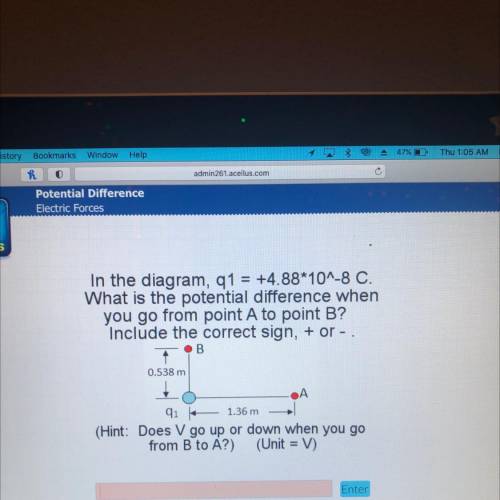
Physics, 22.07.2021 09:20 abecobos37
In the diagram, q1 = +4.88*10^-8 C.
What is the potential difference when
you go from point A to point B?
Include the correct sign, + or - .
B
0.538 m
1.36 m
91 |
(Hint: Does V go up or down when you go
from B to A?) (Unit = V)


Answers: 1


Other questions on the subject: Physics

Physics, 21.06.2019 19:10, shazanah95
Athin, square metal plate measures 14 cm on each side and has emissivity of 0.60. the plate is heated to a temperature of 745°c. what is the rate at which the plate radiates energy ? the stefan-boltzmann constant is 5.67 × 10-8 w/(m2 ? k4). remember that the plate will radiate energy from both its top and bottom surfaces.
Answers: 1

Physics, 22.06.2019 16:50, lizzepacheco
Acommercial refrigerator with refrigerant-134a as the working fluid is used to keep the refrigerated space at -35°c by rejecting waste heat to cooling water that enters the condenser at 18°c at a rate of 0.25 kg/s and leaves at 26°c. the refrigerant enters the condenser at 1.2 mpa and 50°c. if the compressor consumes 3.3 kw of power, determine (a) the mass flow rate of the refrigerant, (b) the refrigeration load, (c) the cop, and (d) the minimum power input to the compressor for the same refrigeration load.
Answers: 2

Physics, 22.06.2019 23:30, selena827
You have two photos of a person walking. one shows the person at the corner of third and main streets, the other shows the person at the corner of tenth and main streets. there are lampposts at every corner in this town, and the first picture shows it to be 10: 32: 00 exactly. the second picture shows it to be 10: 49: 30. you know three facts: (1) all of the clocks are synchronized; (2) there are exactly 12 equal-sized blocks per kilometer in this town; and (3) the streets that cross main in this area are numbered consecutively, with no interruptions. what is the person’s average speed in kilometers per hour?
Answers: 2

Physics, 23.06.2019 02:00, raptortrainor2013
Farmer a has a deep well and needs a lot of water for her animals and crops. her neighbor, farmer b, has a shallower well. he needs less water than farmer a because his farm is smaller. in years of drought, sometimes farmer b can't get any water from his wells. what can farmer b do to decrease the likelihood of his well running dry?
Answers: 3
You know the right answer?
In the diagram, q1 = +4.88*10^-8 C.
What is the potential difference when
you go from point A...
you go from point A...
Questions in other subjects:

Mathematics, 29.03.2021 05:50

English, 29.03.2021 05:50

History, 29.03.2021 05:50



Mathematics, 29.03.2021 05:50




Mathematics, 29.03.2021 06:00


 = Potential at point A =
= Potential at point A = 
 = Potential at point B =
= Potential at point B = 

 = distance of point A from charge = 1.36 m
= distance of point A from charge = 1.36 m = distance of point B from charge = 0.538 m
= distance of point B from charge = 0.538 m


